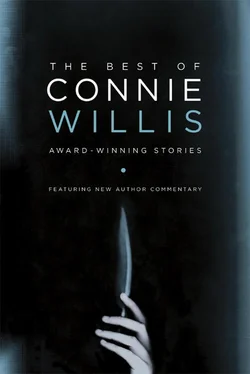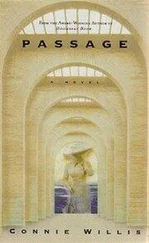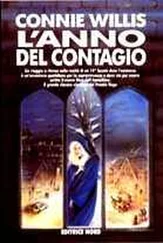A clot of people emerged abruptly from the Circle Line tunnel opposite and jammed up in front of the escalator, chattering in French. Teenagers on holiday, lugging enormous backpacks and a duffel too wide for the escalator steps, stopping, maddeningly, to consult their tube maps at the foot of the escalator.
“Excuse me,” I said, “Pardonnez-moi,” and they looked up, and, instead of moving aside, tried to get on the escalator, jamming the too-wide duffel between the rubber handholds, mashing it down onto the full width of the escalator steps so no one could get past.
Behind us, in the Piccadilly Line tunnel, I could hear the faint sound of a train approaching. The French kids finally, finally, got the bag onto the escalator, and I pushed Cath onto the bottom step, and stepped onto the one below her.
Come on. Up, up. Past posters for Remains of the Day and Forever, Patsy Cline and Death of a Salesman . Below us, the rumble of the train grew louder, closer.
“What do you say we forget going back to our hotel? We’re not far from Marble Arch,” I said to cover the sound. “What say we call the Royal Hernia and see if they’ve got an extra bed?”
Come on, come on. Up. King Lear. The Mousetrap .
“What if it’s not still there?” Cath said, looking down at the depths below us. We’d come almost three floors. The sound of the train was only a murmur, drowned out by the giggling students and the dull roar of the station hall above us.
“It’s still there,” I said positively.
Come on, up, up.
“It’ll be just like it was,” I said. “Steep stairs and the smells of mildew and rotting cabbage. Nice wholesome smells.”
“Oh, no,” Cath said. She pointed across at the down escalators, suddenly jammed with people in evening dress, shaking the rain from their fur coats and theater programs. “ Cats just got out. We’ll never find a taxi.”
“We’ll walk,” I said.
“It’s raining,” Cath said.
Better the rain than the wind, I thought. Come on. Up.
We were nearly to the top. The students were already heaving their backpacks onto their shoulders. We would walk to a phone booth and call a taxi. And what then? Keep our heads down. Stay out of drafts. Turn into the Old Man.
It won’t work, I thought bleakly. The winds are everywhere. But I had to try to protect Cath from them, having failed to protect her for the last twenty years, I had to try now to keep her out of their deadly path.
Three steps from the top. The French students were yanking on the wedged duffel, shouting, “Allons! Allons! Vite!”
I turned to look back, straining to hear the sound of the train over their voices. And saw the wind catch the gray hair of the old woman just stepping onto the top step of the down escalator. She hunched down, ducking her head as it blew down on her from above. From above! It flipped the hair back from the oblivious young faces of the French students above us, lifted their collars, their shirttails.
“Cath!” I shouted and reached for her with one hand, digging the fingers of my other one into the rubber railing as if I could stop the escalator, keep it from carrying us inexorably forward, forward into its path.
My grabbing for her had knocked her off balance. She half-fell off her step and into me. I turned her toward me, pulled her against my chest, wrapped my arms around her, but it was too late.
“I love you,” Cath said, as if it was her last chance.
“Don’t—” I said, but it was already upon us, and there was no protecting her, no stopping it. It hit us full blast, forcing Cath’s hair across her cheeks, blowing us nearly back off the step, hitting me full in the face with its smell. I caught my breath in surprise.
The old lady was still standing poised at the top of the escalator, her head back, her eyes closed. People jammed up behind her, saying irritatedly, “Sorry!” and “May I get past, please!” She didn’t hear them. Head tilted back, she sniffed deeply at the air.
“Oh,” Cath said, and tilted her head back, too.
I breathed it in deeply. A scent of lilacs and rain and expectation. Of years of tourists reading England on $40 a Day and newlyweds holding hands on the platform. Of Elliott and Sara and Cath and me, tumbling laughingly after the Old Man, off the train and through the beckoning passages to the District Line and the Tower of London. The scent of spring and the All Clear and things to come.
Caught in the winding tunnels along with the despair and the terror and the grief. Caught in the maze of passages and stairs and platforms, trapped and magnified and held in the inversion layer.
We were at the top. “May I get past, please?” the man behind us said.
“We’ll find your china, Cath,” I said. “There’s a secondhand market at Portobello Road that has everything under the sun.”
“Does the Tube go there?” she said.
“I beg your pardon,” the man said. “ Sorry .”
“Ladbroke Grove Station. The Hammersmith and City Line,” I said, and bent to kiss her.
“You’re blocking the way,” the man said. “People are trying to get through.”
“We’re improving the atmosphere,” I said and kissed her again.
We stood there a moment, breathing it in—leaves and lilacs and love.
Then we got on the down escalator, holding hands, and went down to the eastbound platform and took the Tube to Marble Arch.
Afterword for “The Winds of Marble Arch”

My favorite place in London is of course St. Paul’s, but my second favorite is not a place, exactly. It’s the whole vast network of the London Underground. It has these wonderful wooden-slatted escalators that go all the way down to the center of the earth, and ceramic-tiled platforms, and on every available post and pillar and wall is posted the tube map, the best map ever drawn.
And just as the Tube isn’t exactly a place, the tube map’s not exactly a map, either. It’s more like a circuit diagram (or a scar on Professor Dumbledore’s knee), and it was designed, believe it or not, by an Underground employee, Harry Beck, in his spare time. It’s a work of genius. It’s ridiculously easy to read and understand, and it’s beautiful in its own right, with all those lovely blue and purple and green lines. It should be hanging in the Tate Gallery, and the Underground should be on the National Trust for Places of Historic Interest. I mean, Charing Cross Station stands on the site of the blacking factory where Charles Dickens worked as a kid. Petula Clark got her start singing in the Tube during the Blitz. Actors like Laurence Olivier and Alec Guinness and Dame Edith Evans gave impromptu performances in Leicester Square Station as the bombs fell, and hundreds of the British Museum’s treasures were stored in the blocked-off tunnels of Chancery Lane. Two men were assigned to guard them, and they lived, cooked, and slept there surrounded by wooden crates full of Pharaohs, Caesars, and Grecian urns.
I discovered the delights of the Underground on my very first trip to London and have adored it ever since, so much so that I was delighted that my novel Blackout / All Clear and “The Winds of Marble Arch” made it necessary for me to spend hours in the Tube taking notes, and I’m ridiculously happy whenever I see it in a movie or on an episode of Dr. Who or the new Sherlock . The TV series Primeval used the old deserted tunnels under the Aldwych, complete with bunks from the Blitz days, in one of its episodes (it was infested with giant bugs from the Carboniferous Era), and the Underground is in lots of great movies, from Hanover Street to Love Actually to Billy Elliott .
Читать дальше













